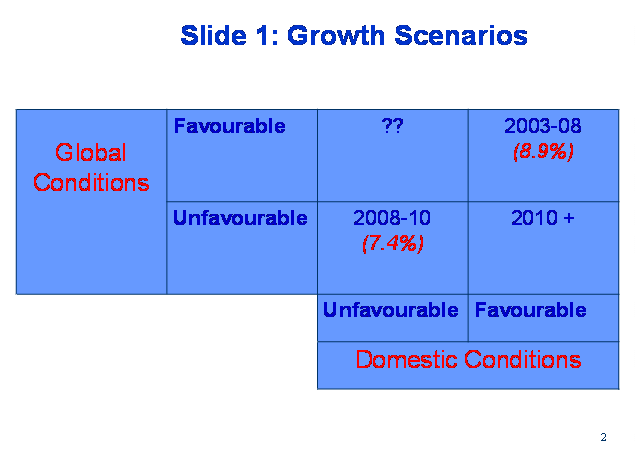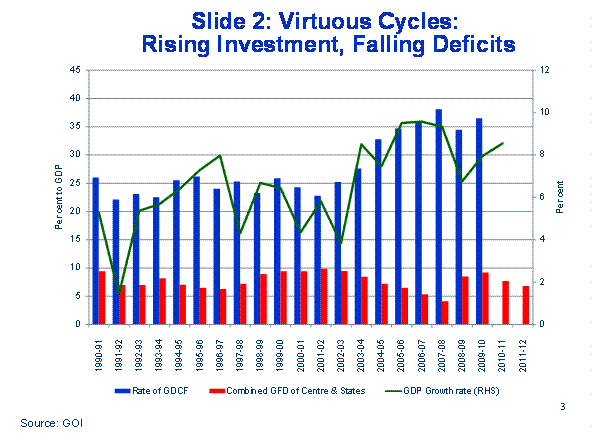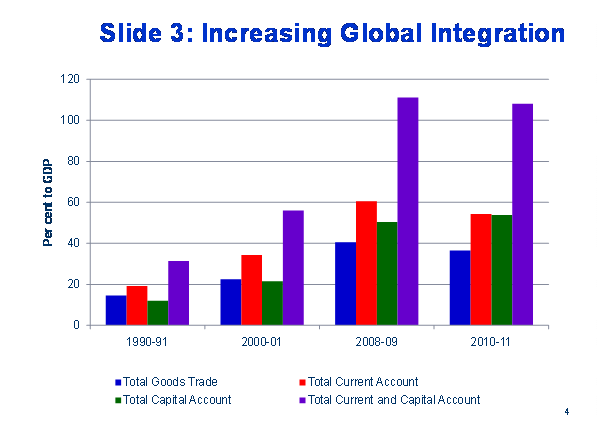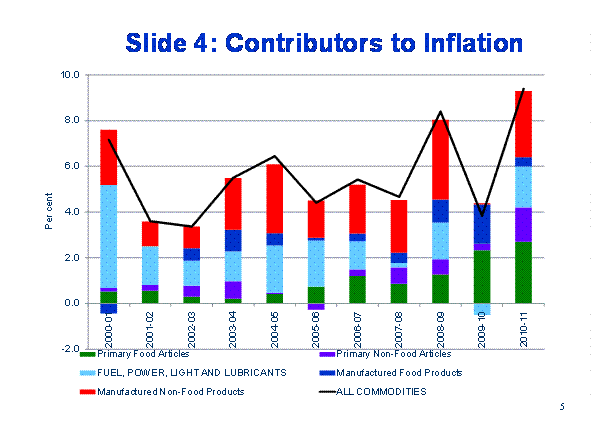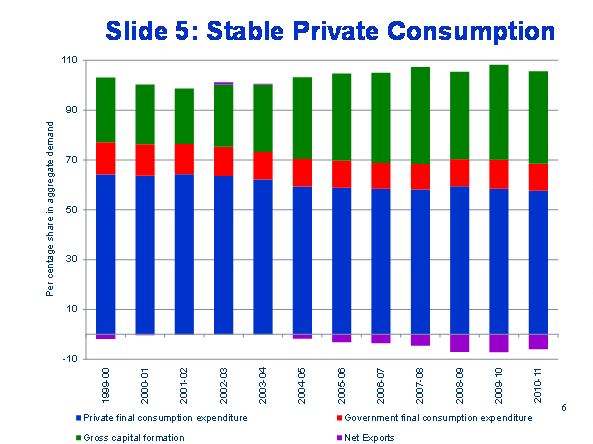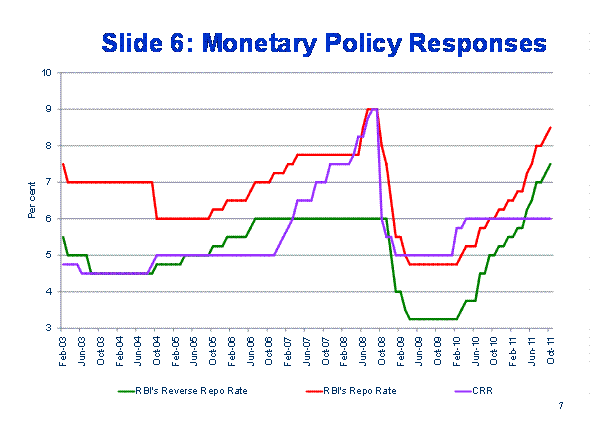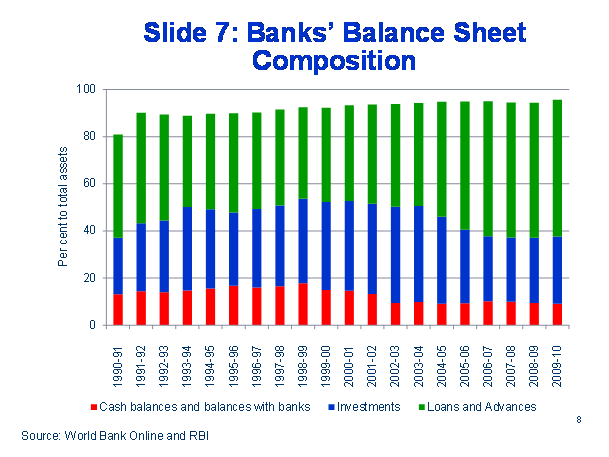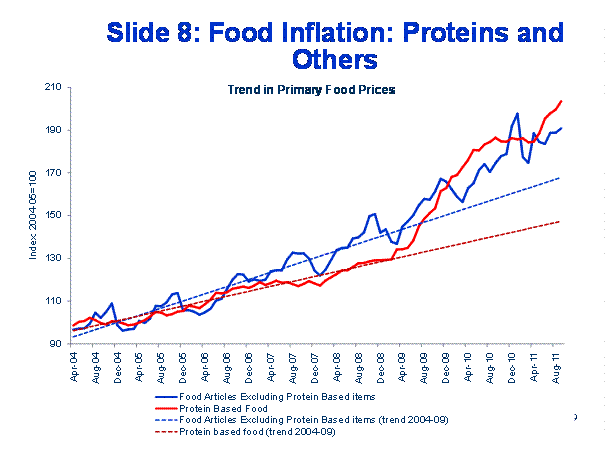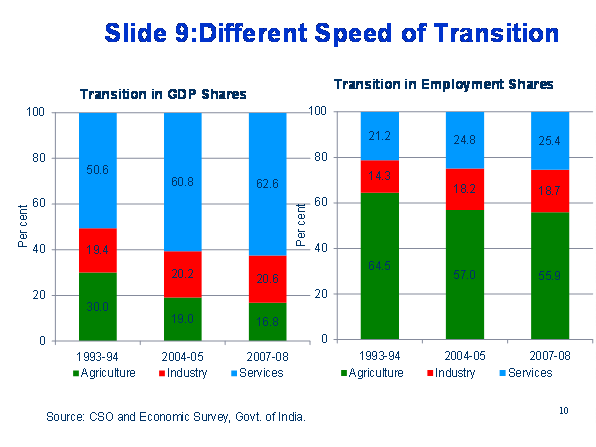 IST,
IST,


वृद्धि, लचीलापन तथा सुधार: संकटोत्तर नीतिगत चुनौतियों पर अनुचिंतन : सुबीर गोकर्ण
डॉ. सुबीर गोकर्ण, उप गवर्नर, भारतीय रिज़र्व बैंक
उद्बोधन दिया नवंबर 03, 2011
|
Introduction It is a privilege and a pleasure for me to be delivering the 45th A. D. Shroff Memorial Lecture. The list of speakers who preceded me reads like an honour roll of the business and policy establishment in our country and I am proud to be a part of this very distinguished set of people. I am also very glad that the venue of the lecture is the Indian Merchants’ Chamber. 2011 marks the 20th anniversary of the reform initiative of 1991. Early that year, IMC and the Indira Gandhi Institute of Development Research (IGIDR), where I was a member of the faculty, collaborated to produce a document entitled “Policy Options for Economic Reform”, which laid out reform blueprints in four domains – trade, finance, labour markets and small and medium enterprises. The sharing of perspectives between businesspersons and academics that went into that document was a critical learning experience for me in the early stages of my career. It motivated me to sustain professional contact with industry associations throughout my career. I certainly benefitted from this contact and I hope that the associations did too! These last 20 years have undoubtedly been a period of dramatic change for the Indian economy. Significantly, much of that change has come about because of the adoption of a policy framework, which was founded essentially on the proposition that the late Mr. Shroff attached great value to – the prominent role of private enterprise in the development process. Of course, as we observe the 20th anniversary of what was clearly a big-bang reform initiative, we can afford to take a more objective and nuanced look back over the period to see how the entire process of change impacted the economy. To put it very broadly, reforms hugely expanded the opportunities for economic activity. This resulted in more rapid growth, to which higher productivity contributed significantly. However, it also brought with it increased risks, particularly with respect to the increased exposure to the global economy that the reform process generated. These risks occasionally manifested themselves during the past 20 years – the Asian crisis of 1997-98 and the impact of the US recession of 2001 on the Indian IT sector in 2001 are two illustrative examples. But, none of these episodes came anywhere close to the magnitude of the impact that the financial crisis of 2008 had on either the global or the Indian economy. Globally, the debate on policy and regulation has been significantly affected by that crisis. Across a number of domains, the emphasis has shifted from the opportunities created by the spread of market forces and free enterprise to the risks that they have introduced into the system. Unbridled enthusiasm about the virtues of the market has given way to, at best, nervousness and at worst, disdain and contempt. Like all such debates, however, the eventual outcome, on which long-term policy thinking and action will be based, will be somewhere in the middle. The relationship between effectively functioning market forces and economic performance cannot be ignored, certainly in an economy in India’s state of development. Sustaining rapid growth is something that market forces have contributed to and that remains an imperative. Equally, the vulnerabilities caused by the greater integration and exposure of domestic markets to the global economy, which was one of the significant outcomes of the development strategy initiated in 1991, cannot be wished away. If economic performance is not to be held hostage by global turbulence, certain safeguards have to be built in to the strategy. The productivity and efficiency gains that emerge from domestic competition and global exposure have to be balanced with safety and stability concerns that might require the imposition of certain boundaries on these forces. The crisis of 2008 has highlighted the need for maintaining a balance between efficiency and stability. Too much emphasis on the former can cause severe problems, as we saw in 2008. Given the degree of global integration, these can spread very quickly around the world. On the other hand, excessive concerns with safety can dilute the benefits that accrue from effectively functioning market forces, both domestically and globally. The central proposition that I want to put forward in this lecture is that the balance between efficiency and stability must be built into the development strategy. Reforms that engender competition, both internal and external, and thereby contribute to greater efficiency and more rapid growth must be complemented with safeguards that address the risks that these forces generate. I will argue that achievement of this balance contributed to both the sharp acceleration in growth that the Indian economy experienced in the five years preceding the crisis and the resilience that it demonstrated in the face of the crisis. I will then go on to talk about some policy challenges in the broad context of this balance between efficiency and stability. An Organizing Framework It is meaningful to analyze the performance of the Indian economy over the past decade or so in terms of the simple framework displayed on Slide 1. The 2x2 matrix shows four scenarios emerging from favourable and unfavourable global and domestic conditions. It is quite easy to classify the period from 2003 to 2010 into two of the boxes. The first five years of this period, i.e. the years preceding the crisis, clearly fall into the top right-hand box, reflecting favourable conditions both globally and domestically. From a growth perspective, this was a dream run for the Indian economy, which averaged 8.9 per cent per year over those five years. To illustrate the power of this rate of growth, GDP would increase by over 50 per cent during a five-year run at this rate and double in about eight-and-a-half years. Many sectors in the economy have experienced the impact that this can have on the demand for their products and services. From both economic policy and business strategy perspectives, this period provides a benchmark for future performance. However, the framework should inject a dose of reality into those expectations. It highlights the fact that this rate of growth was achieved in a clearly favourable global environment, which may not be a characteristic of the next few years! Getting back to the framework, the crisis period, 2008-10, clearly falls into the bottom left-hand box, reflecting unfavourable global and domestic conditions. The financial crisis, of which the tipping point was perhaps the collapse of Lehman Brothers in September 2008, was the most vivid feature of the hostile global environment, but there were several other threats that also manifested themselves in that period. Food inflation soared around the world in the first half of 2008, as did oil prices. Both these trends reinforced the inherent inflationary pressures that were being felt domestically as a result of the sustained high growth. In these circumstances, the monetary policy stance had to be firmly anti-inflationary, culminating in the repo rate reaching its highest ever level of 9 per cent in July 2008. The combination of global turbulence and domestic demand compression would have undoubtedly caused growth to fall, which it did. However, what may have come as a surprise is that it didn’t fall by very much. The economy grew by 6.8 per cent in 2008-09 and by a relatively robust 8 per cent in 2009-10, at a time when much of the global economy was still very sluggish. This was clearly a sign of resilience in the face of a very severe shock, which, I want to re-emphasize, emanated from unfavourable conditions, both globally and domestically. I will now go on to talk about the relationship between the reform process and growth on the one hand and between boundaries and resilience on the other. Reforms and Growth The core premise of the reform process initiated in 1991 was that greater competition, both internal and external would help accelerate economic growth. The entire spectrum of reforms, from the abolition of industrial licensing to the sharp reduction in trade barriers and the termination of allocative controls on finance, were intended to simultaneously introduce competitive forces into the economy, while freeing up the choices that producers had in terms of what, where and how to produce. These choices, in turn, could be supported by a financial system that was allowed to make its own risk-return calculations. Although some essential requirements of a truly competitive market economy, notably the elimination of exit barriers, were not introduced with the same degree of enthusiasm, the reforms that were done turned out to have a powerful impact. Of course, it did not happen all at once. As the line in Slide 2 indicates, the early growth dividends from the 1991 reforms were somewhat short-lived. Growth accelerated to cross the seven per cent threshold during the three years from 1994 to 1997, but slumped back to a rather tepid five per cent for the five years following. This performance legitimately raised questions about the merits of the entire reform process; if the growth dividend was going to be this small, was it worth all the institutional disruption and political challenges that it entailed? As it turned out, the acceleration in growth that took place from 2003 onwards quelled that particular debate. Looking back over that period, a reasonable interpretation of events is that the reform process took long time to fall into place. Trade reform, for example, manifested in a two stage transition, first from quantitative restrictions on imports to tariffs and then the lowering of tariff rates to internationally comparable levels. Similarly, financial sector reforms did not fall into place all at once; they unfolded slowly, across domestic banks, market mechanisms and liberalization of the capital account. The exchange rate regime went through some intermediate steps before current account convertibility was achieved. While industrial licensing for domestic investors was eliminated early on in the process, the policy regime for foreign direct investment also unfolded slowly, contributing to uncertainty about the evolving competitive environment. In a nutshell, this was an evolutionary rather than a revolutionary process. Its full impact, therefore, would only manifest when all of the different forces at work reached a critical threshold – the tipping point. This evidently arrived in 2003, when the growth rate accelerated sharply to over 8 per cent in 2003-04 and, with the exception of a slight dip in the following year, stayed well above that mark for a five-year period, which was represented in the top right-hand box in the scenario matrix. The bars in Slide 2 display a pattern, which, to my mind, is a critical driver of the growth acceleration. The higher set represents the investment-GDP ratio, which clearly accelerated from the 25-30 per cent range before 2003 to over 35 per cent during the high-growth period. An important contributor to this though by no means the only one, was precisely the tipping point; the evolution of reforms in different domains had more or less come to an end, resulting in a significant reduction in uncertainty about the domestic investment environment. A stable environment clearly encouraged investment activity, which was further buoyed by emerging optimism about the huge potential that the domestic market offered. Accelerating investment provided a double bonus; it created new capacity, while speeding up the assimilation of new technology. As a result, more was produced with higher productivity. The lower set of bars also represents a development of enormous significance. The government committed to a fiscal consolidation process through the Fiscal Responsibility and Budget Management Act in 2003. Notwithstanding the transition in the regime in 2004, the consolidation path was adhered to. Very significantly, this was not a commitment of the central government alone; the states contributed as well. The combined centre and state fiscal deficit-GDP ratio steadily declined from 2003-04, bottoming out at about four per cent in 2007-08, the last year before the crisis hit. We should not underestimate the role of this very dramatic expenditure switch between investment and government spending. Keep in mind the fact that the investment-GDP ratio includes public investment, while the fiscal deficit largely comprises a revenue deficit, i.e., what the government borrows in order to meet its operating (as opposed to capital) expenditure. Cutting consumption, while raising investment is a textbook formula for accelerating growth. Its validity was amply demonstrated in the Indian high-growth period of 2003-08. And, this switch was achieved by two reform drivers. First, the set of industrial, trade and financial sector reforms, which, once stabilized, greatly enhanced the attractiveness of investment. Second, government finances were brought under control, in effect, freeing up resources for investment. Having seen the virtues of the reform process in terms of their eventual impact on growth, let us now take a look at the risks that they introduced into the system. Competition is, of course, an inherently risky process and the failure of individual businesses in an intensely competitive environment is only to be expected. But, in the domestic context, this is hardly a disruptive force, since there are also successful outcomes. In other words, there is no systemic risk that emerges from a more competitive domestic environment in most circumstances. However, it is a somewhat different matter when it comes to global exposure. The greater is the degree of integration between the domestic and global economies, the larger are both the opportunities and threats that come with integration. I will focus on two of the risk factors. The first one is the risk stemming from the degree of global integration. As Slide 3 indicates, the Indian economy became significantly more globally integrated. The bars on the slide reflect the gross volumes of activity on the different dimensions depicted. The trade bar represents the sum total of exports and imports, the current account bar the sum total of receipts and payments on that account and so on. On every dimension, the Indian economy has become significantly more globally integrated over the past 20 years, which is an outcome of reforms in both current and capital account transactions as well as very strong performance on both goods and services exports. Significantly, at the time of the crisis, the aggregate of all balance of payments transactions was more than GDP. This is precisely where risk considerations come in. When the crisis hit, across the Emerging Market Economies (EMEs), including India, capital flowed out in large quantities, exerting enormous pressure on exchange rates and domestic liquidity conditions. These channels of transmission highlighted the vulnerability that global integration created for these economies, which were otherwise relatively healthy. Fortunately for them, they had the capacity to respond with appropriate policy measures. I will address this issue in the Indian context a little later in the lecture. The second risk factor that we need to pay attention to is the economy’s dependence on imported energy. Although this is a structural condition, which would have an influence on domestic conditions under any circumstances, the fact is that the rapid growth of the economy did contribute to an overall increase in energy consumption and energy intensity, which made the economy more vulnerable to global energy price shocks. Slide 4 provides an indication of this vulnerability from the inflation perspective. The blue segment of the bar represents the contribution of energy prices overall to headline inflation. Although energy prices are certainly not the only driver of inflation in India, the pattern suggests that, over the past decade, high energy prices have typically been concomitant with high inflation. Boundaries and Resilience As it turned out, the adverse growth impact of the crisis was relatively short-lived. Growth dropped below 7 per cent in 2008-09, the year in which the crisis precipitated, but recovered to 8 per cent in the subsequent year. Although the numbers varied across countries, this was a broader characteristic of EMEs. It was striking to see that the impact of the crisis on the growth performance of developed economies was both large and persistent, while being relatively small and transitory for the EMEs. Clearly, there were some common features that EMEs shared, which contributed to this resilience, but that is too broad a subject to be addressed here. I will confine myself to the possible sources of resilience in the Indian context. To my mind, four factors are important. First, notwithstanding the very large increase in global linkages, the fact is that the Indian economy remains primarily driven by domestic factors. From the demand side, as Slide 5 indicates, the relatively large share of private consumption spending has been a contributory factor to the overall stability of demand. Consumption tends to be relatively resilient in the face of, particularly, transitory shocks, because individuals and households take time to adjust their spending patterns. It is only when the shock turns out to be persistent that patterns will change significantly. In this sense, it is a stabilizing force, giving other sources of demand that can be quickly influenced by policy actions, time to respond to and help mitigate the impact of the shock. Second, the capacity to launch a strong policy response was in place when the crisis hit. On the monetary front, the tight, anti-inflationary stance that preceded the crisis had taken policy rates and the cash reserve ratio to relatively high levels. As the crisis precipitated, it had a dramatic impact on commodity, particularly energy, prices, which then helped inflation move rapidly down, along with other drivers. This, in turn, provided the basis of for a quick and large reversal in the monetary stance. As Slide 6 shows, both policy rates and the cash reserve ratio were significantly reduced over a relatively short period of time. I earlier referred to the risks that increased global integration brought with it. One of the most significant adverse impacts of the crisis on the Indian economy was caused by rapid capital outflows in the immediate aftermath of the collapse of Lehman Brothers. Even for businesses whose fundamentals remained intact, the massive constriction of liquidity could easily have been life-threatening, with a prolonged liquidity shortage escalating into a solvency problem. The massive amount of liquidity that the reversal of the monetary policy stance infused into the system helped to avert that possibility. Fiscal policy also contributed, as was displayed in Slide 2. As indicated earlier, the process of fiscal consolidation that preceded the crisis had put government finances in relatively good shape. In doing so, it had created the capacity to respond to a slowdown in private demand, particularly investment, by quickly ramping up public spending. Of course, the risk inherent in this kind of policy response is that the increased fiscal commitments persist beyond the time they are required. This is a major issue of debate globally. Some countries have attempted to exit from crisis-induced fiscal commitments while private demand is still soft, while others have made more lasting commitments, which, on the back of resilient private demand, have contributed to rising inflationary pressures. Be that as it may, it is important to recognize the fact that fiscal space and the willingness to use it was an important reason for resilience. However, beyond these two contemporaneous sources of resilience, I would like to suggest two structural reasons for why the Indian economy was resilient to the shock. These are what I would describe as “boundaries”. The first of these is the nature of bank portfolios. Slide 7 shows the balance sheet composition of the Indian banking system. The relatively large and stable proportion of loans is an important contributor to resilience. Both in India and across EMEs in general, the balance sheets of banks typically comprised a larger share of loans relative to investments. The latter, being subject to mark-to-market requirements, are vulnerable to sharp downward movements in asset prices. The former also carry balance sheet risks through provisioning requirements for non-performing assets, but in economies that are growing reasonably fast, these are probably less onerous than vulnerabilities to asset prices, which move very sharply in times of market turbulence. Balance sheet adjustments played a critical role in the impairment of financial systems in developed economies, by sharply reducing their capacity to provide finance. In turn, this probably contributed to both the magnitude and persistence of the slowdown in growth. By contrast, while EMEs were hit by liquidity constraints, which I referred to earlier in the Indian context, the stability of balance sheets as a result of a more “traditional” structure helped to preserve the systems’ capacity to provide finance. Liquidity infusions quickly transmitted through to businesses and helped prevent the escalation from liquidity to solvency problems. The second structural factor in the Indian context, in my view, is the capital account management framework. Before the crisis, capital controls were generally seen as a hindrance to smooth global integration and a source of inefficiency. The perspective has changed somewhat, with an emerging view that some kinds of capital controls may provide temporary relief from the instability being transmitted from global shocks through high volatility in capital flows. This is still an evolving global debate, but the Indian experience perhaps makes some contributions to it. Broadly speaking, the Indian approach to capital controls is based on a preference ordering. There are virtually no limits on foreign direct investment, apart from some sector-specific restrictions, which are not directly motivated by macroeconomic considerations. This channel is seen as being growth and productivity enhancing. There are virtually no limits on foreign portfolio investment into equities. In this channel, both market risks and exchange rate risks are fully borne by the foreign investor. However, there are limits on debt flows. These are the least preferred, essentially because the domestic borrower is obliged to repay and bears the exchange rate risk. Within this category, long-term debt is preferred to short-term debt. External debt obligations can put enormous strain on the capital account if they are redeemed in the face of a global shock. Putting some kind of limits on them reduces the vulnerability of the economy to this strain. Looking back over the crisis period, when outflows from equity investments were so large, it is easy to imagine that the pressure and the consequent impact on domestic markets would have been far more intense if debt obligations were also being redeemed at the same time. I would describe the restrictions on debt inflows with respect to quantum, tenure and pricing which are currently in place as “strategic” in nature. They are motivated by the need to impose some limits on the risks of global exposure and not by day-to-day considerations of exchange rate volatility. Consequently, the rupee moves in response to daily supply and demand patterns against the backdrop of these strategic restrictions. In turn, these restrictions can be lowered in response to strategic considerations, such as the increasing demand for foreign funds for infrastructure investment, which has been done over the past year. But, to return to the issue of resilience in the face of the crisis of 2008, it could be argued that the preference ordering reflected in the capital account management framework helped to minimise the severity of the impact on the domestic economy. Policy Challenges Let me repeat the basic argument I am advancing. Reforms were a critical contributor to the acceleration of growth in the Indian economy. However, the reform strategy, as productive as it was, brought with it some risks. Recognition of these risks and the response to them in terms of some boundaries helped the economy to be resilient in the face of a very severe shock. The essential message from this argument is that the combination of growth and resilience comes from a reform process that balances expansion of opportunities with mitigation of risks – efficiency with stability. With this in mind, let me return to the organizing framework that I began the lecture with. The recent past has been categorized into two of the boxes. Let us look at the future in terms of the other two. Of these, the top left-hand box appears at this point in time to be irrelevant. It is difficult to foresee a situation for some time to come in which the Indian economy will be beset by problems while the rest of the world is doing relatively well. That leaves the bottom right-hand box, in which the Indian economy is experiencing favourable conditions, while the rest of the world is not. The unfavourable global conditions postulated in this scenario are certainly a realistic assumption. The question then is: how do we ensure that the domestic economy moves into the favourable zone? This is essentially where the policy challenge lies. Drawing on the reform-growth-resilience triangle, what are the policy priorities, which will help the economy to sustain growth while keeping risks in check? This opens up a wide canvas, but I will confine myself to issues I have covered in this lecture, viewing them from the growth-resilience perspective. First, let me return to the issue of inflation, which I raised in the context of vulnerability to global forces in the form of rising energy prices. This clearly calls for an integrated energy strategy, with the objective of both conserving overall use of energy and shifting the balance to domestic resources, preferably renewable ones. However, from a somewhat broader perspective, the continuing vulnerability to inflationary shocks from energy can also be mitigated by addressing other sources of inflation, over which there is a greater degree of control for domestic policy. In this context, I would like to emphasize the very real threat from food inflation. A growing demand-supply imbalance in some major food items – protein sources, vegetables and fruits – is helping entrench food inflation. Slide 8 shows clear signs of an escalating trend. This raises the average rate of inflation, making the system even more vulnerable to external energy shocks or, for that matter, any other source of inflation. There are some direct growth-resilience implications of this pattern. It is a historical given that people diversify their diets as they become more affluent. One key common characteristic of long-term development is that the food economy has accommodated this by more efficient supply (either through production or trade) of the foods that people want more of. If this does not happen, households tend to spend more money on food and less on other things, which acts as a damper on the growth of demand for non-food products. As was suggested earlier, aggregate private consumption expenditure can be a stabilizing force; the more diversified it is, the more it can contribute to stability. But, macroeconomic implications apart, from a development and welfare perspective, it is a matter of concern that increased access to better nutrition is hindered by rising food prices. Rapidly expanding supply is really the only solution to this problem. Second, continuing with the theme of diversification as way to promote growth with resilience, the sectoral composition of GDP and employment suggest key policy priorities. Slide 9 displays a striking contrast between the drivers of GDP growth and the pattern of employment. While agriculture has been steadily shrinking in terms of its share of GDP, its share in employment remains both dominant and relatively static. In effect, a constant proportion of the labour force is generating a declining share of output. On the other hand, industry, which is expected to be a natural absorber of workers from agriculture, providing them more productive and better paying jobs, has not just about maintained its share in both GDP and employment. It has clearly not played the role of an engine of either growth or employment. High dependence on services for GDP growth and on agriculture for employment is clearly a source of vulnerability. Balancing out the share of GDP with the share of the labour force does not necessarily have to be one-for-one; however, the shares should be moving with some rough correspondence to provide stability to the growth process. What needs to be done to facilitate rapid growth in industry is well known. Infrastructure is a key requirement. Labour regulations need to be streamlined. Workers need to be appropriately skilled. Taxes need to be streamlined. This is a long and familiar agenda on which, there are many welcome signs of progress – the New Manufacturing Policy, the Goods and Services Tax, the National Skill Development Corporation, amidst others, are all initiatives that provide a foundation for the sector to emerge as an engine of growth and employment. But, all these various dimensions need to reach certain thresholds together before their full benefits will be realized. Earlier in the lecture, I spoke about the cumulative impact of a variety of reforms causing a sudden and massive acceleration in growth – the tipping point. We must learn from that experience the lesson that the more various reform initiatives are synchronized, the quicker that tipping point will arrive. Time is not a luxury we can count on in this context. Third, growth with stability requires strong support from a financial system that can also grow with stability. The post-crisis perspective on financial sector development emphasizes strongly capitalized banks along with restrictions on deployment of funds, with a view to maintaining robust balance sheets. In India as well as in many EMEs, a more conventional or traditional approach to banking, with its emphasis on lending as opposed to investment, appears to have been a source of resilience. At the same time, too much conservatism may reduce the ability of the financial system to meet the evolving financial requirements of a rapidly growing economy. In this context, a strategy for financial development needs to continually balance the ability to introduce new ways of financing new opportunities with the means to measure and mitigate the risks that these opportunities bring. It really is a tightrope walk, from which it is very easy to fall off on either side! Finally, with respect to capital account management, the key lesson from the experience of the crisis is that a combination of strategic capital controls and a floating currency can provide an effective buffer against global financial turbulence. The controls described earlier impose some limits on the vulnerability of the domestic economy to external shocks. Within these boundaries, a floating exchange rate acts as a shock absorber. It eliminates the burden on policymakers to either absorb surplus inflows, with potentially inflationary consequences, or accommodate outflows, with potentially adverse implications for credibility. Concluding Remarks I would like to conclude by re-emphasizing three key messages from the lecture. First, reforms, which balanced growth opportunities with risk mitigation contributed to both the Indian economy’s growth performance before the crisis of 2008 and its resilience to the crisis. Second, the future performance of the Indian economy depends even more heavily on reinforcing domestic drivers of growth and stability in a generally unfavourable global environment. Third, drawing on lessons from past experience, speed, synchronization and the balance between exploiting opportunities and managing risk, will maximize the dividends from any reform strategy. Let me end by thanking the Forum of Free Enterprise for honouring me with the invitation to deliver the 45th A.D. Shroff Memorial Lecture, the Indian Merchants’ Chamber for hosting the event, the New India Assurance Company for sponsoring it and all of you for participating.
|
पृष्ठ अंतिम बार अपडेट किया गया:






